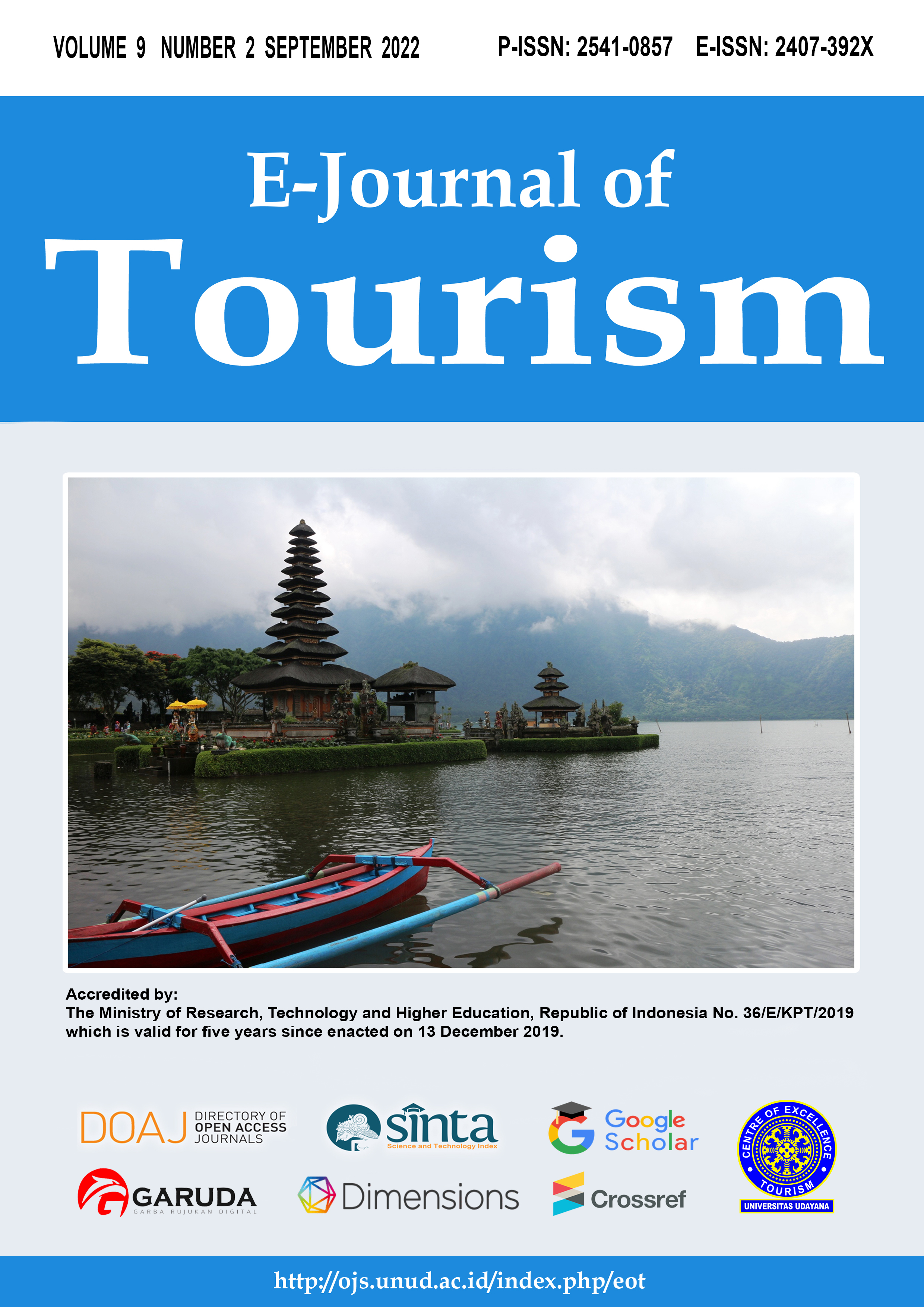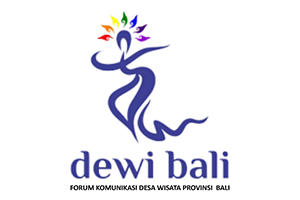Tourist Satisfaction Patterns and Index for Travel Companions While Traveling in Bali
Abstract
The travel of tourists to a destination forms a pattern of tourist travel. Likewise, a tourist's journey during a trip has an influence on satisfaction and tourists in terms of the choice of destinations visited, memories made, joy in traveling, as well as the tendency to be more important between the chosen destinations compared to travel companions. This study aims to analyze the pattern of tourist travel and the index of tourist satisfaction with travel companions in traveling in Bali. This study uses a large sample with the Slovin formula for an error level of 4 percent. Questionnaires were distributed by accident to 600 tourists. Data were analyzed by Importance Performance Analysis, Customer Satisfaction Index and qualitative descriptive. The characteristics of tourists who travel to Bali are relatively young adults in terms of age and education and a high level of mastery of technology. Most tourists look for information on the internet in addition to recommendations from family and friends before tourists travel to Bali. This reflects that there has been a change in the use of travel services, media promotion, advertising and other prints. The pattern of door trips visiting Bali shows a spider web pattern, which is the first center (hub) pattern from entering tourist attractions spread across regencies/cities in Bali. The level of suitability of travel indicators in traveling in Bali shows that it is not appropriate or does not meet the expectations of tourists to Bali in general. Tourist satisfaction with travel companions in the index of traveling in Bali is 83.97 (very satisfied/appropriate).
Keywords: travel patterns, travel companions, tourist satisfaction, Bali
Downloads
References
Aritonang, R.L. 2005. Kepuasan Pelanggan. Jakarta: Gramedia.
Ben, Sarbini Mbah. 2018. Filsafat Pariwisata, Sebuah Kajian Filsafat Praktis. Yogyakarta: Pustaka Pelajar.
Blazeska, Daliborka, Zoran Strezovski, and Angela Milenkovska Klimoska. 2018. The Influence of Tourist Infrastructure on the Tourist Satisfaction in Ohrid. UTMS Journal of Economics, 9 (1): 85-93.
Bowen David and Jackie Clarke. 2009. Contemporary Tourist Behavior. London: CABI Publishing.
Filieri, Raffaele, Frase McLeay, and Bruce Tsui. 2017. Antecedents of Travelers’ Satisfaction and Purchase Intention from Social Commerce Websites. In Schegg, R. and Stangl, B. (Eds.). Information and Communication Technologies in Tourism 2017, Proceedings of the International Conference in Rome, Italy, January 24-26, 2017. Springer, Wien, pp. 517-528. http://www.springer.com/gp/book/9783319511672. DOI: 10.1007/978-3-319-51168-9_37.
Frenandes, Teresa and Mariana Cruz. 2016. Dimensions and Outcomes of Experiences Quality in Tourism: The Case of Port Wine Cellars. Journal of Retailing and Consumer Service, 31: 371-379.
Gerson, Richard F. 1993. Measuring Customer Satisfaction: A Guide to Managing Quality Service. Menlo Park: Crisp Publications.
Giese, Joan L. and Joseph A. Cote. 2002. Defining Consumer Satisfaction. Academy of Marketing Science Review, 2.000 (1). Available: http://www.amsreview.org/articles/giese01-2000.pdf Copyright © 2002 – Academy of Marketing Science.
Grigoroudis, Evangelos and Yanis Siskos. 2010. Customer Satisfaction Evaluation Methods for Measuring and Implementing Service Quality. London: Springer.
Hasan, Ali. 2008. Marketing. Yogyakarta: MedPress.
Hill, Nigel. 1996. Handbook of Customer Satisfaction Measurement. Hampshire: Gower Publishing.
Ladhari, Riadh. 2009. Service Quality, Emotional Satisfaction, and Behavioral Intentions: A Study in the Hotel Industry. Managing Service Quality, 19 (3): 308-331.
Larsen, Svein. 2007. Aspects of a Psychology of the Tourist Experience. Scandinavian Journal of Hospitality and Tourism, 7 (1): 7-18. DOI: 10.1080/15022250701226014.
Qu, Hailin, Lisa Hyunjung, and Holly Hyanjung Im. 2011. A Model of Destination Branding: Integrating the Concepts of the Branding and Destination Image. Tourism Management, 32 (3): 465-476. DOI: 10.1016/j.tourman.2010.03.014.
Radder, Laetitia and Xiliang Han. 2013. Perceived Quality, Visitor Satisfaction and Cinative Loyalty in South African Heritage Museums. International Business & Economics Research Journal, 12 (10), October 2013.
Rajaratnam, Sushila Devi, Vikneswaran Nair, Saeed Pahlevan Sharif, Uma Thevi Munikrishnan. 2015. Destination Quality and Tourists’ Behavioral Intentions: Rural Tourist Destinations in Malaysia. Worldwide Hospitality and Tourism Themes, 7 (5): 463-472 © Emerald Group Publishing Limited 1755-4217 DOI 10.1108/WHATT-06-2015-0026.
Saha, Gour C. and Theingi. 2009. Service Quality, Satisfaction, and Behavioral Intentions: A Study of Lowcost Airline Carriers in Thailand. Managing Service Quality, 19 (3): 350-372. DOI: 10.1108/09604520910955348.
Schnaars, Steven P. 1991. Marketing Strategy: a Customer Driven Approach. New York: The Free Press.
Selstad, Leif. 2007. The Social Anthropology of the Tourist Experience. Exploring the “Middle Role”. Scandinavian Journal of Hospitality and Tourism, 7 (1), 19-33. DOI: 10.1080/15022250701256771.
Soteriades, Marios. 2017. Experiential Dimensions and Their Influence on Behavioral Intentions within the Context of Nature-Based Tourism. Tourism and Hospitality Management, 23 (1): 35-50. DOI: 10.20867/thm.23.1.7.
Smith, Mary-Anne, Gayle Jennings, and Anoop Patiar. 2016. Quality Tourism Experiences: A Qualitative Study of Australian Gold Coast Residents’ Perspectives as in a Group Tour to China. Travel and Tourism Research Association: Advancing Tourism Research Globally. https://scholarworks.umass.edu/ttra/2014/Student_Colloquium/9.
Stamboulis, Yeoryios and Pantoleon Skayannis. 2003. Innovation Strategies and Technology for Experience-Based Tourism. Tourism Management, 24 (1): 35-43. DOI: 10.1016/S0261-5177(02)00047-X.
Sukanthasirikul, Kanchana and Wannee Trongpanich. 2015. Cultural Tourism Experience on Customer Satisfaction: Evidence from Thailand. 10th International Scientific Conference on Economic and Social Development-Miami, 25th September 2015.
Suwena, I Ketut dan Ni Ketut Arismayanti. 2020. Sistem Pariwisata. Denpasar: Cakra Media Utama.
Tjiptono, Fandy dan Gregorius Chandra. 2011. Pemasaran Strategik. Edisi 2. Yogyakarta: Penerbit ANDI.
Wang, Tz-Li, Phuong Thi Kim Tran, and Vinh Trung Tran. 2017. Destination Perceived Quality, Tourist Satisfaction and Word-of-Mouth. Tourism Review, 72 (4): 392-410. Emerald Publishing Limited. ISSN 1660-5373. DOI 10.1108/TR-06-2017-0103.
World Tourism Organization. 1993. Sustainable Tourism Development: A Guide for Local Planners. Madrid: World Tourism Organization.
Zeithaml, Valarie A., Leonard L. Berry and A. Parasuraman. 1993. The Nature and Determinants of Customer Expectations of Service. Journal of the Academy of Marketing Science, 21 (1): 1-12. DOI: 10.1177/0092070393211001.

This work is licensed under a Creative Commons Attribution 4.0 International License.
The copyright of the received article shall be assigned to the journal as the publisher of the journal. The intended copyright includes the right to publish the article in various forms (including reprints). The journal maintains the publishing rights to the published articles.




















